‘Jettison!’ — A Chinook Crew’s Incredible Story of Survival Over Afghanistan
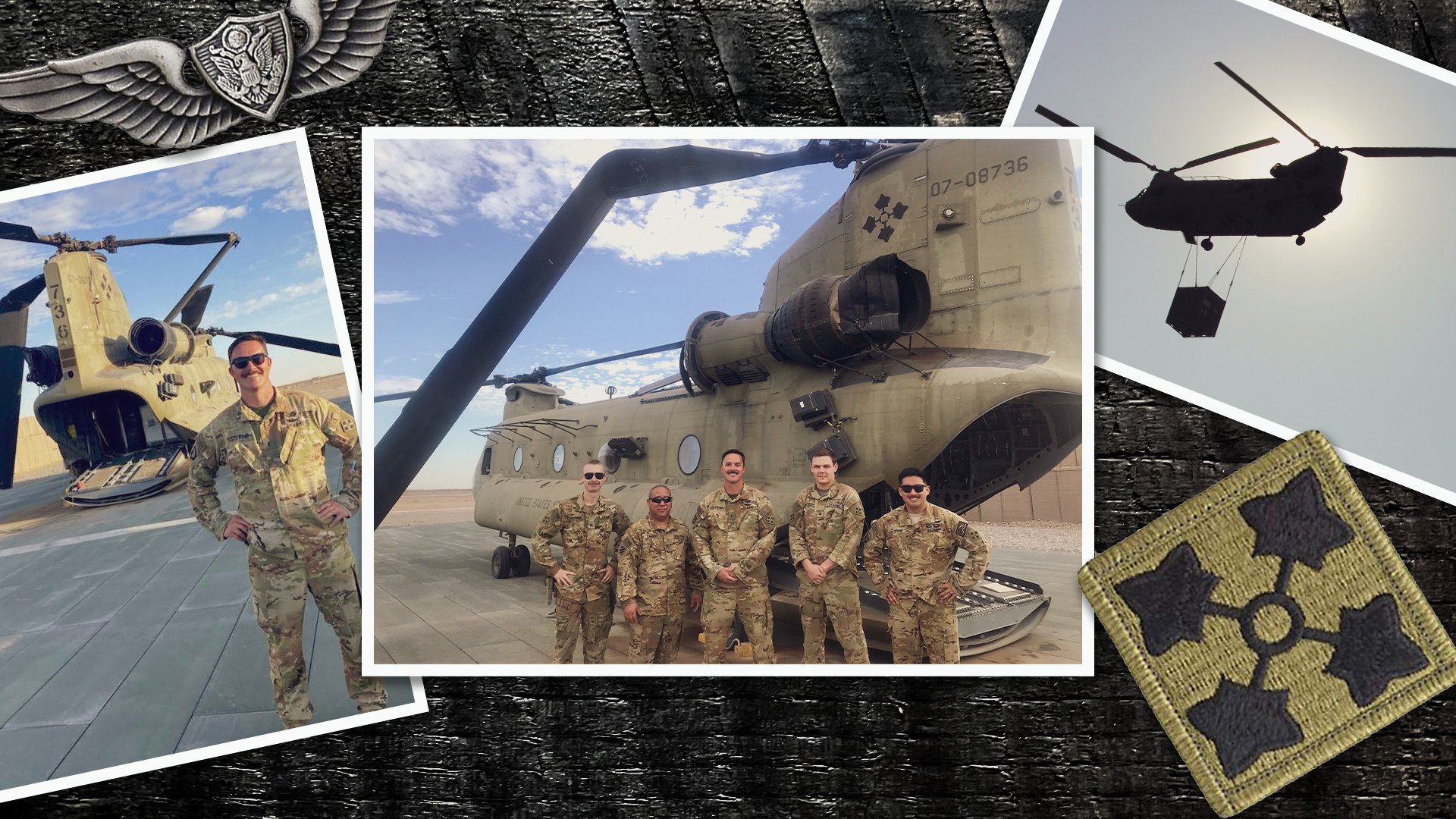
The crew of CASC 73 received the US Army Aviation Broken Wing Award for safely landing this CH-47 with severe rotor damage. Photos courtesy of Washington National Guard and Ryan Schwend. Composite by Coffee or Die Magazine.
It was Bang Bang Chicken night. And that was bad news.
It was an odd thought to have as Ryan Schwend wrestled with the controls of CASC 73, his suddenly crippled CH-47 Chinook. A thousand feet in the air over Helmand province in Afghanistan, the helicopter had just suffered a million-to-one in-flight disaster and was barely still flying. A wayward cargo load had struck the Chinook's rear rotors and was now pinned to the bottom of the helicopter.
Schwend didn’t know the full extent of the damage but did know that to have any hope of landing safely, he would need a ground crew at his base, Camp Dwyer, to clear the debris from the helicopter’s belly as he hovered.
If CASC 73 could still hover at all.
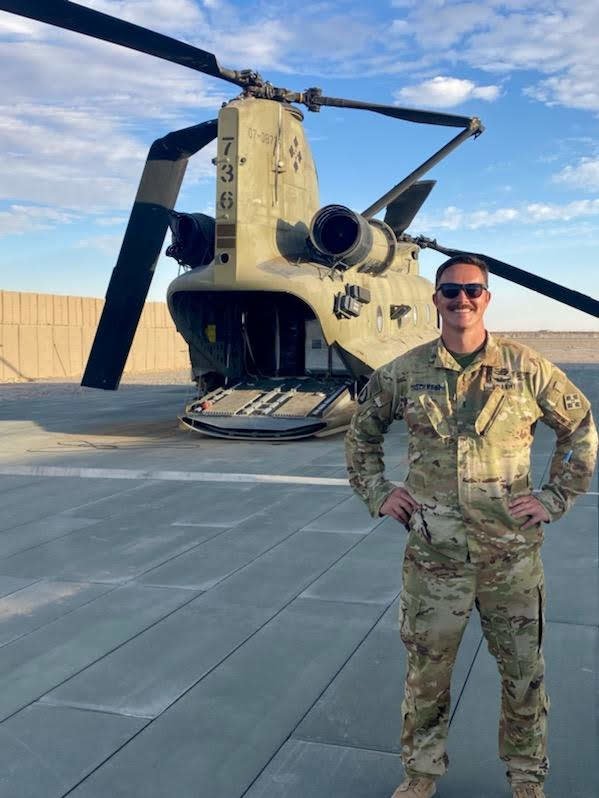
Chief Warrant Officer 3 Ryan Schwend stands near the Chinook CASC 73. Photo courtesy of Ryan Schwend.
But through the stress and chaos, a stray thought popped into his mind — Dwyer’s dining facility was scheduled to serve Bang Bang Chicken that night, a fried, sweet and spicy dish and a weekly favorite.
"It's the only good night of food at the chow hall," Schwend told Coffee or Die Magazine this week. "I was worried that everybody in our TOC would be in line for midnight chow and not on the radio."
Last week, Schwend, a chief warrant officer three in the Washington National Guard, and the rest of the crew of CASC 73 were awarded the Army’s Broken Wing Award for the November 2020 flight in which they limped the fatally damaged Chinook back to Camp Dwyer — where, it turned out, someone was monitoring the radios.
"Fortunately, they were still in the TOC," recalls Schwend. "They jumped in a pickup truck and came out to the ramp as we got closer."
CASC 73 wasn’t on the ground yet, but they were close — even if the crew still didn’t fully grasp the scope of the in-flight disaster their helicopter had just suffered.
'I Thought We Were Hit'
The night's mission for CASC 73 — short for Cascade, the call sign used by Washington Guard Chinooks at home — was simple if grueling: flying as a two-ship with another Chinook, the crew would make two round-trip flights between Camp Dwyer and Kandahar. As the US moved forces out of Kandahar, the Chinooks at Dwyer under the 4th Combat Aviation Brigade's Task Force Mustang had been tasked to move, one by one, more than 100 specialized cargo containers, each hollowed out to be a miniature, portable dorm room. Too bulky to fit inside the Chinook, the 4,000-pound mini-dorms, known as RLBs, were instead sling-loaded below the helicopters, one by one, dangling 20 feet underneath the CH-47’s belly on a set of nylon cargo straps.

Five crew members pose in front of their damaged CH-47 Chinook helicopter. All five were awarded the US Army Aviation Broken Wing Award for safely landing the damaged aircraft. From left: Sgt. Ty Higgins, Staff Sgt. Ben Kamalii, Chief Warrant Officer 3 Ryan Schwend, Sgt. Andrew Donley-Russell, and Chief Warrant Officer 2 Eugene Park. Photo courtesy of Washington National Guard.
Schwend, a pilot for Alaska Airlines in civilian life, estimates the Chinooks at Dwyer had moved close to 150 of the boxes in the previous month, of which Schwend figures he'd flown close to 50 himself. But even if the mission was old hat, it was still night flying in Afghanistan, and as CASC 73 approached Dwyer for the final time, the crew had been in the air nearly seven hours.
"In an airliner, you sit back, you drink coffee and chill," he said. "In a Chinook, under NVGs, in Afghanistan environment, with no A/C, seven hours is a long time."
Schwend’s co-pilot on CASC 73 was one of the Washington Guard’s newest pilots, Chief Warrant Officer 2 Eugene Park. Park, said Schwend, had just graduated flight school prior to the deployment. But he was no novice soldier, nor stranger to stressful moments.
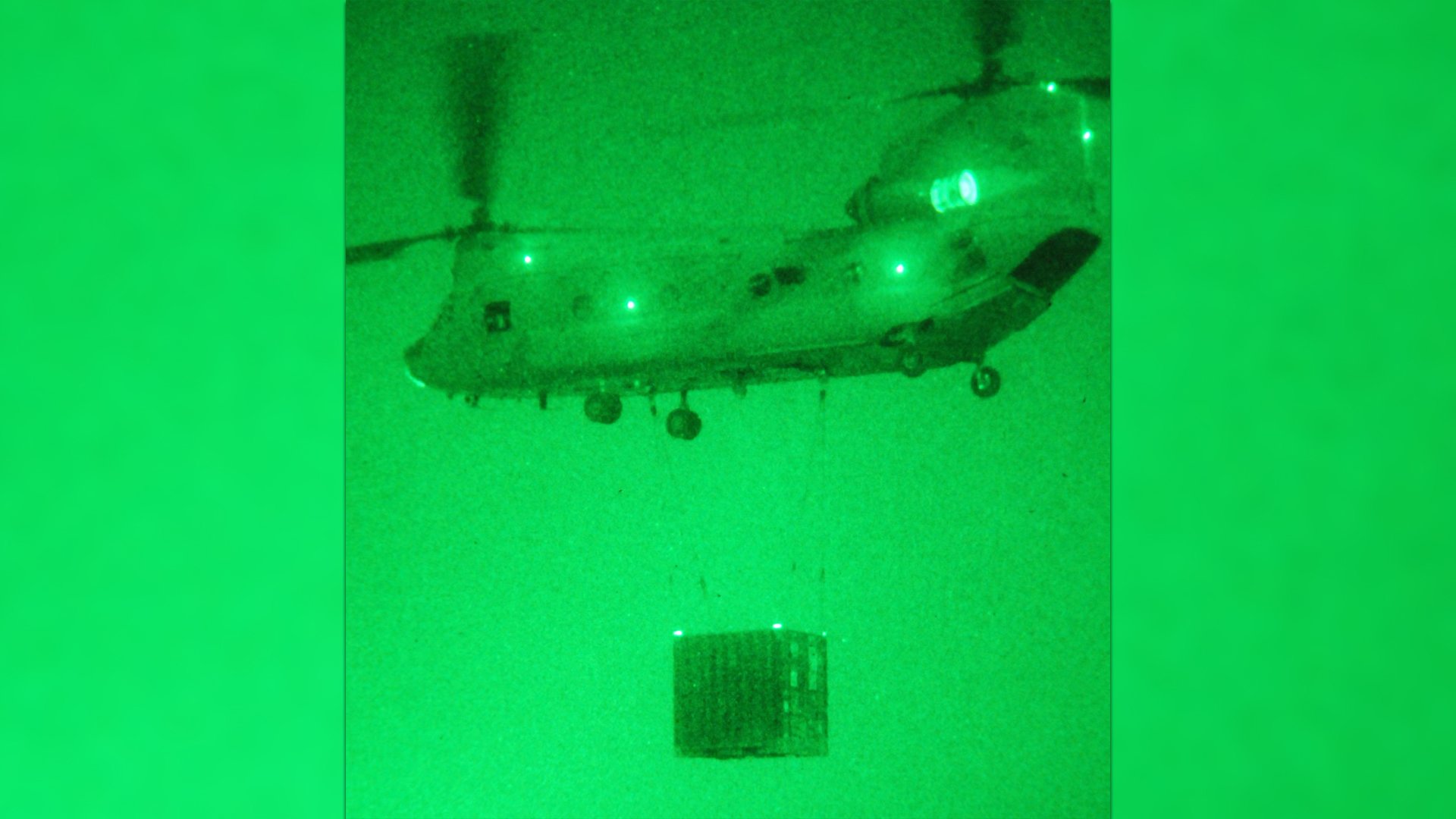
An 82nd Airborne Division CH-47 Chinook sling-loads a cargo container in 2009 with rigging similar to that used by CASC 73. US Army photo by Staff Sgt. James Selesnick.
In civilian life, Park was a Tacoma firefighter. And prior to taking a warrant officer slot in the Washington Guard to fly, he’d been an active-duty artillery officer, graduating Ranger School.
The rest of the crew included Staff Sgt. Ben Kamalii, Sgt. Andrew Donley-Russell, and Sgt. Ty Higgins. All were from Bravo Company of the Washington Guard’s 1st Battalion, 168th General Support Aviation Battalion.
As the less experienced pilot in need of approach and landing practice, Park was on the controls as CASC 73 neared Dwyer.
“We had just started our approach," said Schwend. “We were flying over the Helmand Valley at about a thousand feet when a loud thunderous bang was heard in the aircraft, louder than anything I have ever heard in a Chinook.”
At first, the crew suspected the worst.
"I thought we were hit with a weapons system," Schwend told Coffee or Die.

Broken rotor blades on the CH-47 of CASC 73. Photo courtesy of Ryan Schwend.
The truth was nearly as bad.
A panel on the RLB beneath the helicopter had come open, instantly collapsing the container from a solid brick-shaped box into thin, kitelike sheets of metal.
Flying at close to 100 mph, the load instantly caught wind and, still tethered to the helicopter, whipped upward, impacting all three blades on the Chinook's rear rotor.
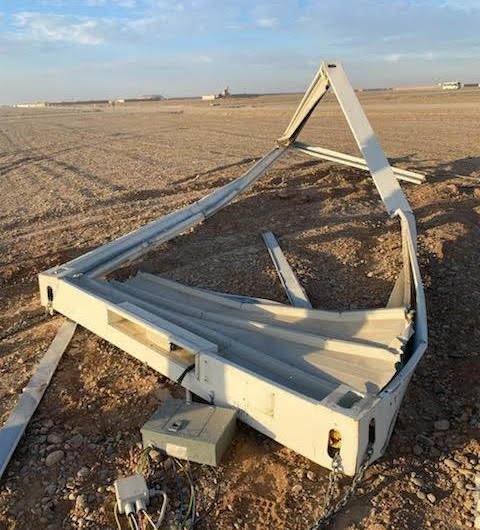
Part of the relocatable building, or RLB, that collapsed, shashed into the blades and become lodged under CASC 73. Photo courtesy Ryan Schwend.
Miraculously, all stayed attached to the rotor, but the impact pulled the Chinook sideways.
"The helicopter immediately banked really hard and abruptly to the right," said Schwend.
As the helicopter rolled, Park calmly steadied the controls.
“If he had snapped [the controls] over, it could have sheared the blades off immediately," Schwend said. "But he very gently corrected the aircraft."
'Jettison! Jettison! Jettison!'
In back, crew chief Higgins reacted almost instantly, yelling"Jettison! Jettison! Jettison!" into the intercom, informing the crew that he was releasing the sling load.
Chinooks have redundant systems to shed a sling load in an emergency — a primary automated system to sheer away the cables and, should that fail, a hard release point that a crew member can physically release themselves.
After trying both, Higgins realized that the load was still attached.
Incredibly, after the load hit the rotors, it swept across the side of the Chinook, where its cargo straps became wedged onto an array of bulky equipment — flares, radars, and antennas — bolted to the side of the helicopter.
With the straps stuck, the wrecked cargo box swung back under the helicopter and became pinned underneath it.
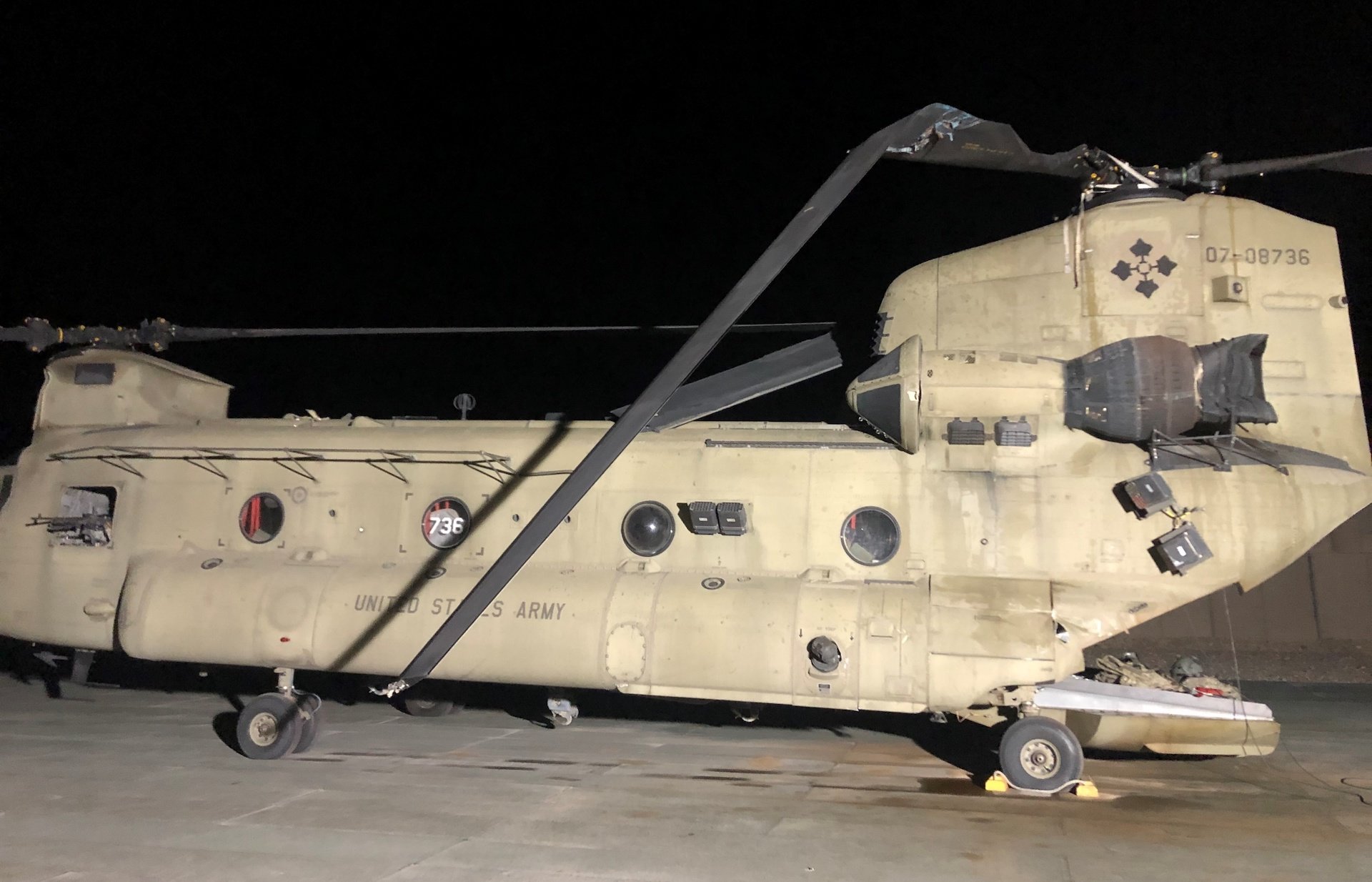
Five members of the Washington National Guard's 1st Battalion, 168th General Support Aviation were awarded the U.S. Army Aviation Broken Wing Award for safely landing the CH-47 with severe rotor damage. (Courtesy photo)
Though the crew ran through more procedures and ideas, it was soon obvious that there was no way to cut it free.
Still, the helicopter was stable, though the controls were mushy and slow to respond. Which gave Schwend a big decision to make: They could try to land immediately, the standard emergency procedure for a helicopter; or try to make it to Dwyer, which the crew could see ahead.
Schwend said he made a quick calculation — just how broken was this helicopter?
If he took the Chinook down for a by-the-book immediate landing, they might quickly be on the ground but the stress of rapidly descending might cause more damage, possibly ending in a crash. If they stayed on the smooth approach to Dwyer, CASC 73 would be in the air longer — again, possibly ending in a crash — but the slow, steady descent would put less stress on the damaged aircraft. Also, firetrucks and other emergency services would be waiting at Dwyer.
“It was my decision to continue,” Schwend said.
As they neared Dwyer, the crew was so absorbed by keeping the helicopter flying that Schwend had yet to make a radio call as they passed over the camp's perimeter. He first asked the other Chinook on the flight to go around, leaving the airfield open, and then called the 168th’s tactical operations center, praying someone had skipped the Bang Bang Chicken.
'I Owe Them My Life'
In fact, several 168th soldiers were in the TOC, and within seconds of CASC 73’s call for help, five sprinted to nearby pickup trucks and raced toward the base’s cargo yard.
First to arrive was Sgt. 1st Class Doug Taylor. A second pickup, driven by Chief Warrant Officer 3 Will Flathers, arrived with Staff Sgt. Joe Ford, Staff Sgt. Kevin Lamp, and Sgt. Marcus Hickman.
There, outlined against the pitch black Afghan night, they saw the Chinook hovering unsteadily, with the mangled mass of the RLB wedged underneath. If CASC 73 tried to land, it would almost certainly belly onto the RLB and likely tip over.
Somehow, they had to get the smashed RLB off.
Hickman put on an aviation headset and tuned into the helicopter’s wireless intercom, punching in a code that allowed him to talk directly to the crew hovering just above his head.
Driving the pickup, Flathers maneuvered the truck under the helicopter, as Lamp and Ford stood in the bed, reaching up to tug on the mess of cables and straps.
After a few attempts, Lamp managed to grab the strap that was holding the load in place and, using a pocketknife, sawed through it.
The RLB dropped clear.
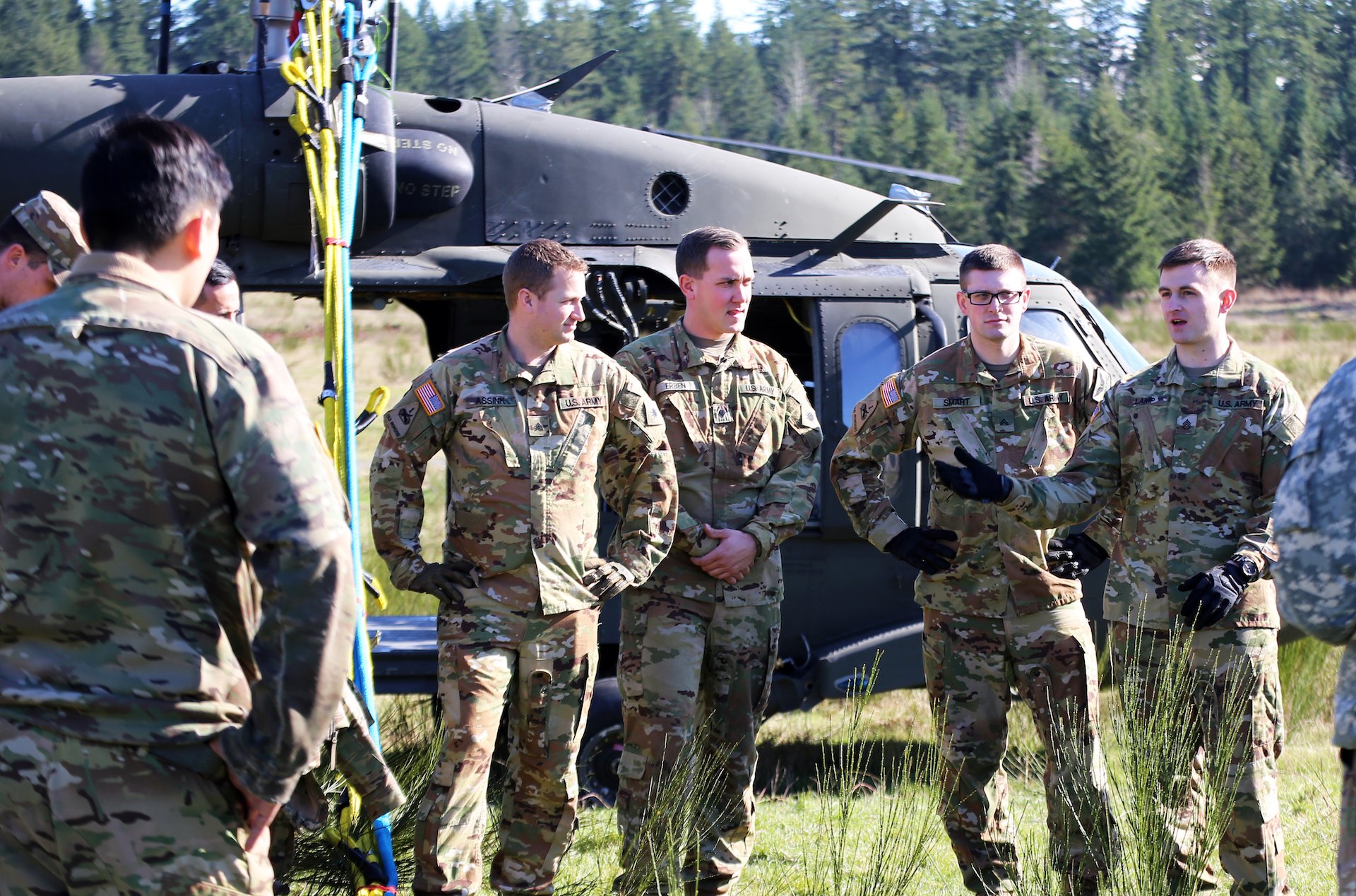
Staff Sgt. Kevin Lamp (right, speaking), a flight engineer with Bravo Company, 1st Battalion, 168th General Support Aviation, during sling-load training at Joint Base Lewis-McChord, Washington, on Feb. 20, 2020. Lamp cut free the hung-up cargo load beneath CASC 73 with a pocketknife. Washington National Guard photo by Joseph Siemandel.
“Not on them, thankfully,” said Schwend.
That left a final decision — land immediately and shut down or hover-taxi to the nearby helicopter pad.
Along with the pickup of their own troops, Schwend said, the cargo ramp quickly filled with firefighters and other emergency personnel, some as close as 20 feet from the hovering Chinook. If something happened as they landed — or as the engines stopped — they might all be in danger.
Moving the controls as gingerly as possible, Schwend flew the helicopter the last few hundred yards to a parking spot and set down.
As the engines wound down, Higgins spoke up: “It looks like the blades are sagging.”
Within seconds, one of the blades — bent badly out shape — slammed against the fuselage, stopping abruptly.
Climbing out of the Chinook, the crew found themselves alone for several minutes as the ground responders were slowed from reaching them by fences and barricades. Seen from the outside, the damage was obviously catastrophic. At least two of the blades were snapped, held together only by a skin of carbon fiber. The blades had stayed “straight” during the flight only due to centripetal force but were otherwise broken and useless.
That the helicopter had stayed in the sky — let alone stayed flyable — was miraculous.
“We went from the craziness of the flight to the absolute silence of the Afghanistan night,” Schwend said. “We all hugged each other. It was a very emotional scene.”
Broken Wing
On June 18, Army Aviation Safety officials presented the crew of CASC 73 with the Broken Wing Award, a rarely given citation for aviators who, “through outstanding airmanship, minimize or prevent aircraft damage or injury to personnel during an emergency situation.”
Though leaders in the 168th submitted the crew and the ground responders for awards including Air Medals, the crew on CASC 73 received Army Commendation Medals, while the ground crew received Army Achievement Medals.
Read Next: Secret Mission to Kabul: The C-17 Crew That Helped Launch the Afghan Airlift

Matt White is a former senior editor for Coffee or Die Magazine. He was a pararescueman in the Air Force and the Alaska Air National Guard for eight years and has more than a decade of experience in daily and magazine journalism.
BRCC and Bad Moon Print Press team up for an exclusive, limited-edition T-shirt design!
BRCC partners with Team Room Design for an exclusive T-shirt release!
Thirty Seconds Out has partnered with BRCC for an exclusive shirt design invoking the God of Winter.
Lucas O'Hara of Grizzly Forge has teamed up with BRCC for a badass, exclusive Shirt Club T-shirt design featuring his most popular knife and tiomahawk.
Coffee or Die sits down with one of the graphic designers behind Black Rifle Coffee's signature look and vibe.
Biden will award the Medal of Honor to a Vietnam War Army helicopter pilot who risked his life to save a reconnaissance team from almost certain death.
Ever wonder how much Jack Mandaville would f*ck sh*t up if he went back in time? The American Revolution didn't even see him coming.
A nearly 200-year-old West Point time capsule that at first appeared to yield little more than dust contains hidden treasure, the US Military Academy said.












